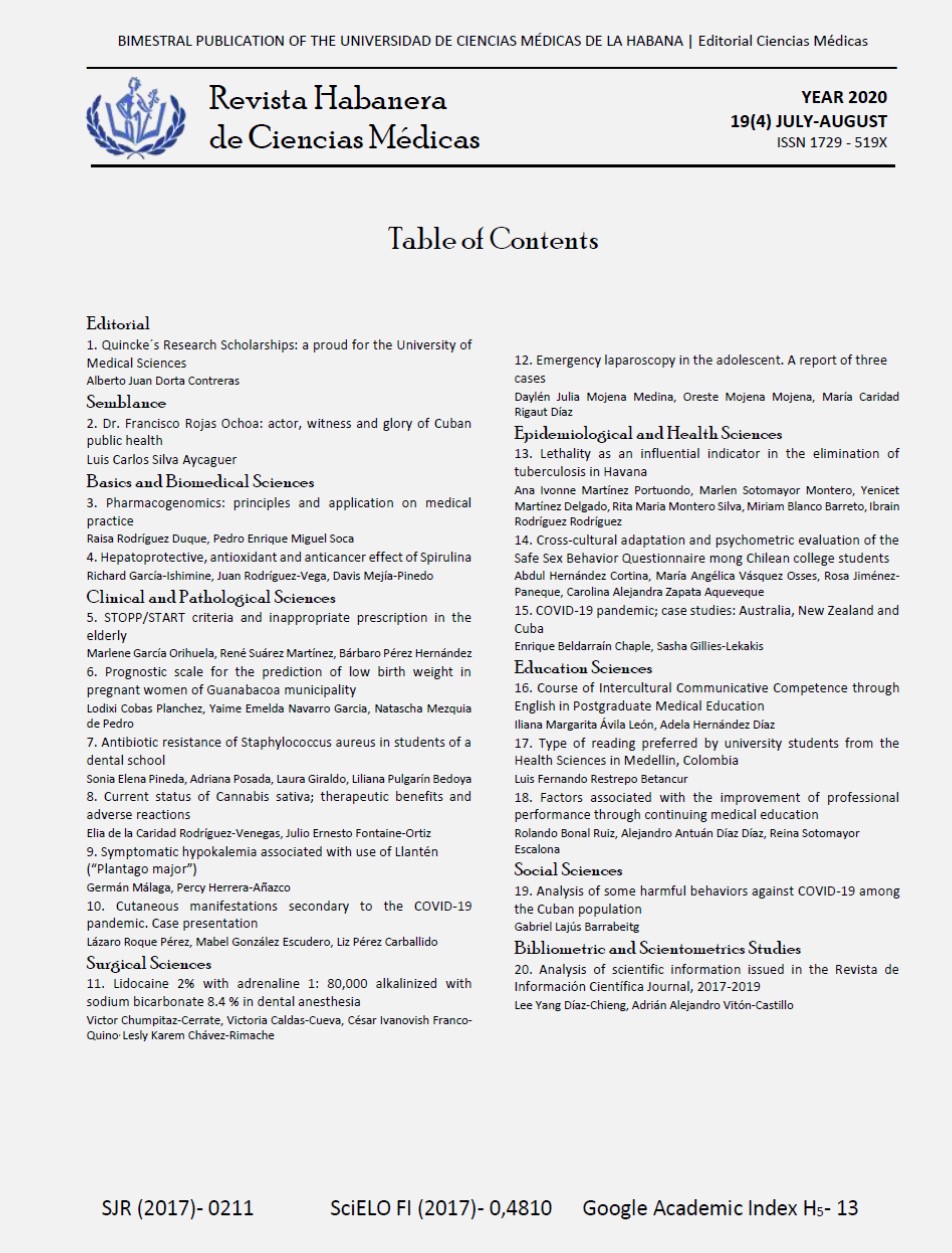STOPP/START criteria and inappropriate prescription in the elderly
Keywords:
inappropriate prescription, polypharmacy, elderly.Abstract
Introduction: Aging not only promotes molecular and cellular damage with progressive deterioration of body functions, but this process transcends treatments and predisposes to potentially inappropriate prescriptions and polypharmacy. This situation complicates the care of the elderly with greater use of health services and drug expenses.
Objective: To identify possible potentially inappropriate prescriptions and estimate the influence of biomedical factors on polypharmacy in hospitalized elderly people.
Material and Methods: Quasi-experimental before-after study which collected information on biomedical variables from the medical records of 200 hospitalized patients at the Longevity, Aging and Health Research Center. The STOPP/START criteria were used to identify potentially inappropriate prescriptions. Descriptive and inferential statistical tests were performed (α = 0.05).
Results: A total of 349 inappropriate STOPP prescriptions and 357 inappropriate START prescriptions were identified upon admission. The section corresponding to the central nervous system contributed 24.8% of the inappropriate STOPP prescriptions and the cardiovascular system revealed 59.9% of the inappropriate START prescriptions. Polypharmacy was present in 43.0% of the elderly and comorbidity was the variable that showed the greatest strength of association with polypharmacy (OR = 8.65; 95% CI: 4.51–16.59), followed by the presence of two or more inappropriate prescriptions according to the STOPP criteria.
Conclusions: The STOPP/START criteria identify inappropriate prescriptions in the Cuban healthcare context which has a negative impact on polypharmacy in the elderly. The central nervous system and the cardiovascular system showed the highest number of potentially inappropriate prescriptions.
Downloads
References
1.Bayarre Vea HD. Múltiples perspectivas para el análisis del envejecimiento demográfico. Una necesidad en el ámbito sanitario contemporáneo. Rev Cub Sal Púb [Internet]. 2017 [Citado 30/11/2018];43(2):[Aprox. 2 p.]. Disponible en: http://scielo.sld.cu/scielo.php?script=sci_arttext&pid=S08643466201700020001
2. Ministerio de Salud Pública. Dirección de Registros Médicos y Estadísticas de Salud. Anuario Estadístico de Salud 2018. La Habana: MINSAP; 2019.
3. Bayarre Vea HD, Álvarez Lauzarique ME, Pérez Piñero JS, Almenares Rodríguez K, Rodríguez Cabrera A, Pría Barros MC, et al. Enfoques, evolución y afrontamiento del envejecimiento demográfico en Cuba. Rev Panam Sal Púb [Internet]. 2018 [Citado 24/01/2019];42:e21. Disponible en: https://doi.org/10.26633/RPSP.2018.21
4. Morales A, Rosas GM, Pinzón EY, Paredes YV, Rosero M, Hidalgo A. Condiciones médicas prevalentes en adultos mayores de 60 años. Acta Med Colomb. 2016; 41:21-8.
5. Mestres C, Agustí A, Puerta L, Barba M. Prescription of potentially inappropriate drugs for geriatric patients in long-term care: improvement through pharmacist’s intervention. Eur J Hosp Pharm. 2015 Jul;22(4):198-201.
6. Galvin R, Moriarty F, Cousins G, Cahir C, Motterlini N, Bradley M, et al. Prevalence of potentially inappropriate prescribing and prescribing omissions in older Irish adults: findings from The Irish Longitudinal Study on Ageing study (TILDA). Eur J Clin Pharmacol. 2014;70(5):599-606.
7. Gallo C, Vilosio J, Saimovici J. Actualización de los criterios STOPP-START, una herramienta para la detección de medicación potencialmente inadecuada en ancianos. Evid Act Pract Ambul. 2015; 18(4):124-29.
8. González Rodríguez P, Castillo Pérez V, Hernández Simón G, Quintana García E, Gutiérrez Gutiérrez M. Polifarmacia en el adulto mayor: es posible su prevención?. Rev Cienc Méd. 2014; 18(5):791-801.
9. Manterola C, Otzen T. Estudios Experimentales. 2ª Parte. Estudios Cuasi-Experimentales. Int J Morphol. 2015; 33(1):382-7.
10. Lwanga SK, Lemeshow S. Determinación del tamaño de las muestras en los estudios sanitarios. Ginebra: Organización Mundial de la Salud; 2004.
11. Jasso Olivares JC, Tovar Serrano A, Cuadros Moreno J. Prevalencia de prescripción de medicamentos potencialmente inapropiados a la población geriátrica de un hospital privado de la Ciudad de México. Med Int Mex. 2011; 27(6):527-34.
12. Luz Martínez I, Chaves P , Peláez M. Envejecimiento activo y participación social. En: Abizanda Soler P, Rodríguez Mañas L. Tratado de Medicina Geriátrica. Fundamentos de la atención sanitaria a los mayores. España: Elsevier; 2015.p.36-9.
13. Bermejo Boixareu C, Saavedra Quirós V, Gutiérrez Parres B, Núñez González A, Cerezo Olmos C, Sánchez Guerrero A, et al. Detección de prescripción inapropiada de fármacos en pacientes mayores institucionalizados atendidos en el servicio de urgencias. Rev OFIL. 2016; 26(1):20-5.
14. Argoullon L, Manciaux MA, Valance A, Bonneville A. Potentially inappropriate prescribing in elderly patient: analyze before/after hospitalization. Geriatr Psychol Neuropsychiatr Vieil [Internet]. 2018 [Citado 30/01/2019];16(2):155-63. Disponible en: https://www.ncbi.nlm.nih.gov/m/pubmed/29877182/?i=4&from=hospitalization%20stopp/start
15. Katzung BG. Drugs used in Heart Failure. In: Basic & Clinical Pharmacology. 24 ed. New York: McGraw Hill Education; 2018. p. 212-27.
16. Mendoza L, Reyna N, Bermúdez V, Nuñez J, Linares S, Nucette L, et al. Impacto de la polimedicación en la calidad de vida de adultos mayores institucionalizados en un centro geriátrico del estado Zulia. Archivos Venezolanos de Farmacología y Terapéutica [Internet]. 2016 [Citado 30/11/2018];35(2):47-52. Disponible en: http://www.redalyc.org/articulo.oa?id=55949906003
17. Serra Urra P, Germán Meliz JL. Caracterización de adultos mayores con polifarmacia evaluados en la consulta de geriatría. Rev Cub Med Mil [Internet]. 2014 [Citado 30/01/2019];43(3):285-92. Disponible en http://scielo.sld.cu
18. Terán Álvarez L, González García MJ, Rivero Pérez AL, Alonso Lorenzo JC, Tarrazo Suárez JA. Prescripción potencialmente inadecuada en pacientes mayores grandes polimedicados según criterios STOPP. Semergen [Internet]. 2016 [Citado 03/02/2019];42(1):2-10. Disponible en: http://dx.doi.org/10.1016/j.semerg.2014.10.018
19. Galindo Ortego G, Cruz Estevea I, Real Gatiusb J, Galván Santiago L, Monsó Lacruz C, Santafé Soler P. Pacientes con el diagnóstico de insuficiencia cardiaca en Atención Primaria: envejecimiento, comorbilidad y polifarmacia. Aten Primaria [Internet]. 2011 [Citado 03/02/2019];43(2):61-8. Disponible en: http://doi.org.10.1016/j.aprim.2010.03.021
20. Lazcano Botello GA, Rodríguez García R. Evaluación geriátrica. En: Lazcano Botello GA, Rodríguez García RM, Medina Chávez JA. Práctica de la Geriatría. 3 ed. México: McGraw-Hill; 2015. p. 123-49.



